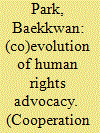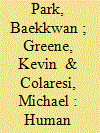| Srl | Item |
| 1 |
ID:
167398


|
|
|
|
|
| Summary/Abstract |
How does the discussion of human rights issues change over time? Without advocates adopting a human rights issue in the first place, international ‘shaming’ cannot occur. In this article, we examine how human rights discussions converge and diverge around new frames and new issues over time. Human rights norms do not evolve alone; their prevalence, framing, and focus are all dependent on how they relate to other norms in the advocacy community. Drawing on over 30,000 documents from dozens of human rights organizations from 1990 to 2011, we provide a temporal overview and visualization of the ebb and flow of human rights issues. Using our new dataset and state-of-the-art methods from computer science, our approach allows us to quantitatively examine (a) how new issues emerge in the advocacy network, (b) the relationship of these new issues to extant human rights advocacy and information, and (c) how the framing and specificity of these issues change over time. By focusing on the process by which a new issue gets incorporated into the work of advocates, we provide an empirical assessment of the first step in the causal process connecting shaming to improvement in human rights practices.
|
|
|
|
|
|
|
|
|
|
|
|
|
|
|
|
| 2 |
ID:
174462


|
|
|
|
|
| Summary/Abstract |
This manuscript helps to resolve the ongoing debate concerning the effect of information communication technology on human rights monitoring. We reconceptualize human rights as a taxonomy of nested rights that are judged in textual reports and argue that the increasing density of available information should manifest in deeper taxonomies of human rights. With a new automated system, using supervised learning algorithms, we are able to extract the implicit taxonomies of rights that were judged in texts by the US State Department, Amnesty International, and Human Rights Watch over time. Our analysis provides new, clear evidence of change in the structure of these taxonomies as well as in the attention to specific rights and the sharpness of distinctions between rights. Our findings bridge the natural language processing and human rights communities and allow a deeper understanding of how changes in technology have affected the recording of human rights over time.
|
|
|
|
|
|
|
|
|
|
|
|
|
|
|
|